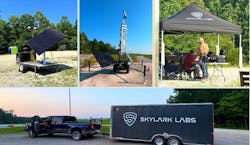Skylark Labs' ARIES System Demos Detection of RF-Silent "Dark Drones" at Camp Atterbury
Skylark Labs announced a breakthrough in autonomous aerial threat detection following a successful field demonstration of its Aerial Reconnaissance and Elimination System (ARIES) at Camp Atterbury, Indiana.
During a recent multi-agency exercise, ARIES was able to detect, track, and classify a new generation of small, non-emitting Unmanned Aerial Systems (sUAS), commonly referred to as "dark drones." These aerial threats, which emit no radio frequency (RF) signals or electronic signatures, have proven exceptionally difficult for traditional detection systems to identify and are widely deployed in modern conflict zones such as Ukraine.
As part of the live evaluation, ARIES was tested alongside multiple commercial and military-grade sUAS detection platforms. ARIES leveraged high-resolution optical sensors, radar, and Skylark's proprietary AI algorithms to autonomously detect, track, and classify multiple "dark" drone platforms in real-time.
ARIES also identifies new drone shapes and configurations never seen before without requiring prior signatures or profiles.
Built for operational flexibility, ARIES functions as a standalone counter-sUAS solution or can be seamlessly integrated into existing platforms, bridging critical detection gaps. The system is deployed on Skylark Labs' Scout MK1 Towers, which house onboard sensors for real-time threat monitoring. All detection data is streamed to the command center.
"This is a pivotal advancement in the global counter-UAS mission," said Dr. Amarjot Singh, CEO of Skylark Labs. "ARIES is designed to detect the undetectable—those drones that fly under the radar, both literally and electronically. This demonstration validates our vision: to build adaptive, AI-powered systems that thrive in the complexity of real-world combat and security scenarios."
